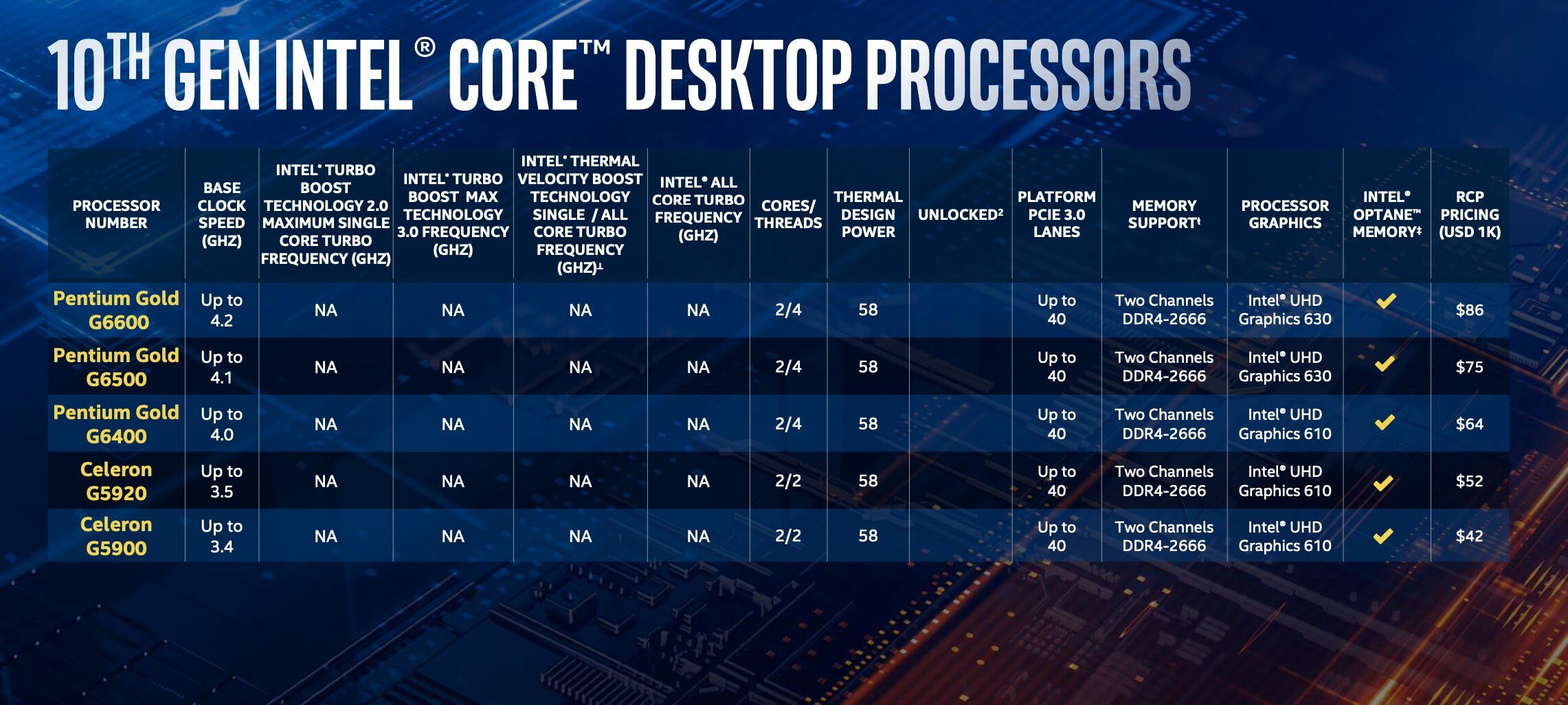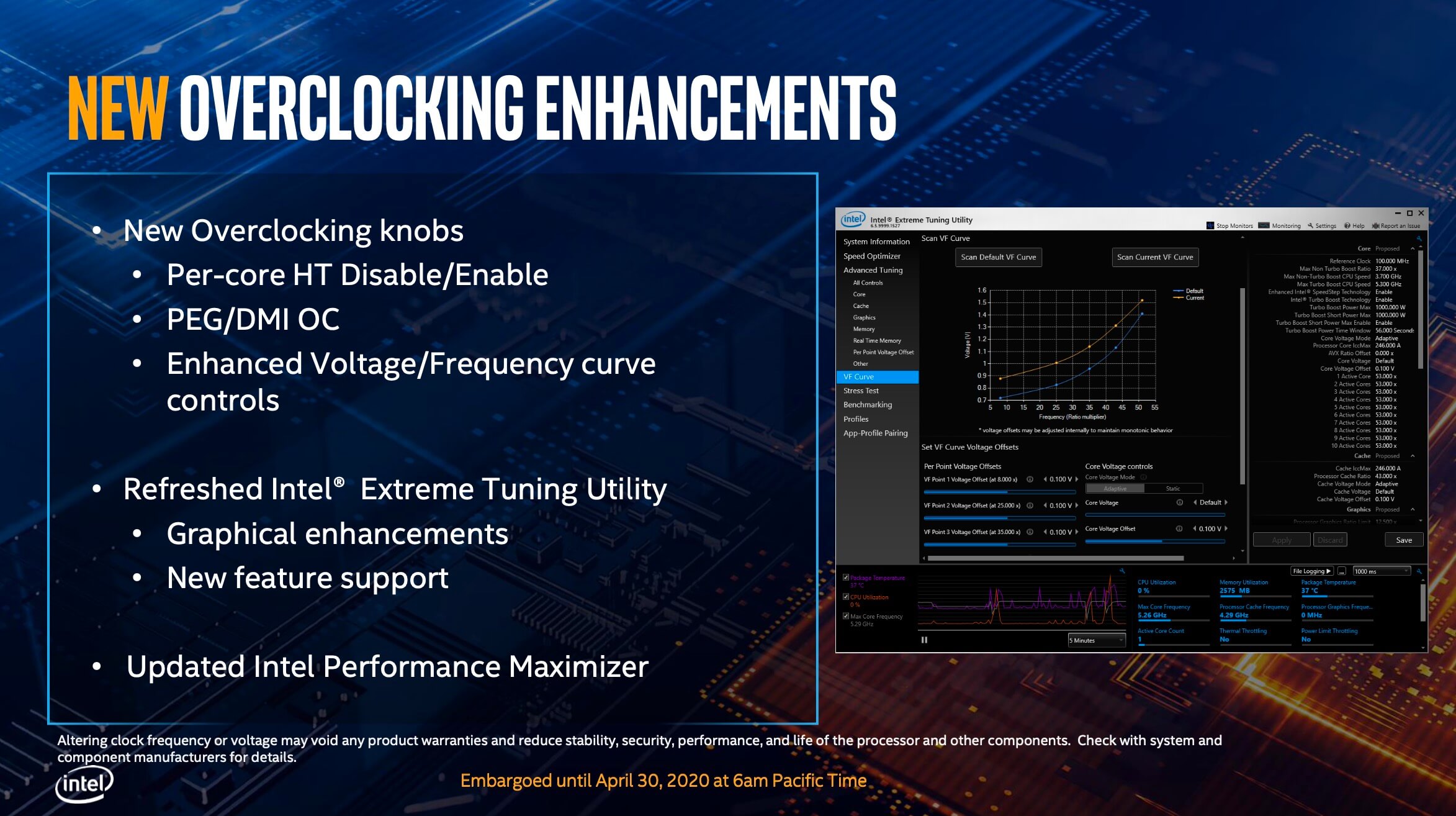In context: Intel's new Core i9-10900K CPU comes equipped with 10 cores, 20 threads and new Turbo frequencies to go head to head against the Ryzen 9 3900X and possibly become the new gaming flagship processor. Meanwhile, the new Core i7 and Core i5 range look very competitive not just in terms of specs and expected performance, but most importantly, in pricing and value against otherwise very aggressive Ryzen rivals.
This has been a long time coming and today we can finally share with you the official information on Intel's 10th gen desktop processors in their Comet Lake lineup. No more leaks, this is the official info, and we'll be sharing a few of our thoughts on what Intel is offering along the way.
At the top of the product stack, Intel is offering a new 10-core, 20-thread processor or set of processors. The flagship Core i9-10900K is a fully unlocked chip with an integrated GPU, and alongside it we have the i9-10900KF which is the same with no iGPU, and two more locked models in the i9-10900 and i9-10900F.
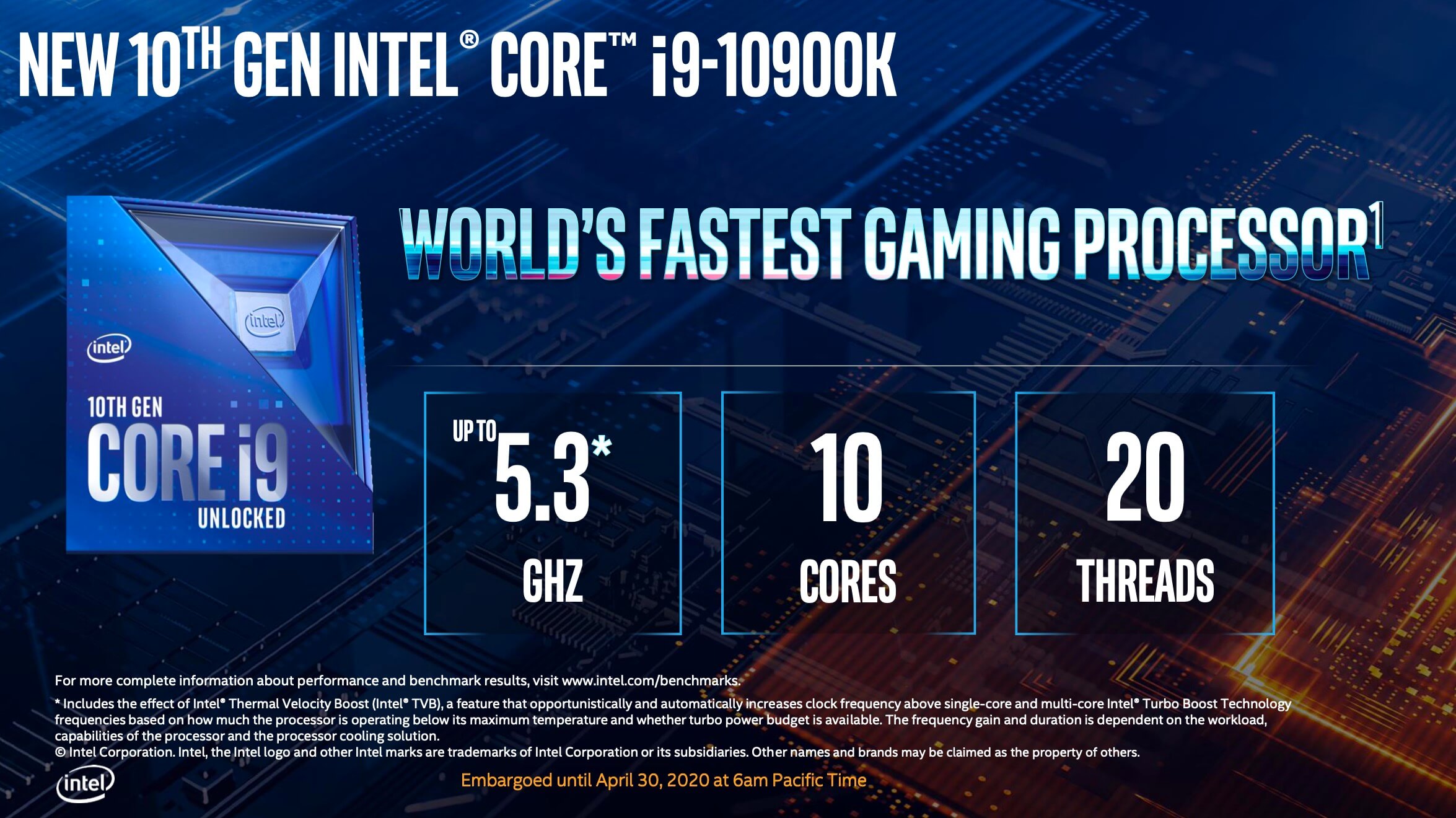
We're still looking at a Skylake-derivative architecture built on 14nm technology, meaning there's no major changes to IPC or CPU features. There's a minor improvement to memory support on paper, up to DDR4-2933 for Core i9 and Core i7 models, though Intel CPUs easily support faster memory and have done so with previous generations, too.
Clock speeds get a few different specifications which can either be confusing or you can simply disregard most of it until we review the CPUs and know where they stand. Either way, what you see in the specs table are three metrics for single-core Turbo speeds: there is the normal Turbo Boost speed of 5.1 GHz, then the Turbo Boost 3.0 speed of 5.2 GHz, and the Intel Thermal Velocity Boost Turbo of 5.3 GHz. Depending on what features you have available to you, and the temperature of the CPU, you'll see clocks between 5.1 GHz and 5.3 GHz peak on these parts. The top 5.3 GHz speed will only be seen at temperatures below 70C as part of Thermal Velocity Boost.
For all-core Turbos, Intel is listing that at 4.8 GHz and 4.9 GHz with Thermal Velocity Boost. The listed TDP for this chip is 125W, though realistically the 10900K and KF will use far more power at a 4.8 GHz all-core frequency, especially as Intel are basically adding two cores to the 9900K at a similar frequency. That higher TDP does allow for a higher base clock though.
For pricing, the 10900K and 10900KF are coming in around $490 and $470, so slotting exactly where the 9900K and 9900KF were in the lineup. This places the 10-core squarely in competition with AMD's Ryzen 9 12-core as expected.
While the 10900 series is interesting in that Intel are now offering 10 cores in a mainstream part – definitely due to the pressure of the Ryzen 9 3900X and 3950X – we think the most juicy parts in the lineup are actually in the Core i7 range, so lets take a look.
The setup is similar to the Core i9 range with standard, F, K and KF SKUs at a range of price points. But the big story here comes in the form of the Core i7-10700K and 10700KF, which are essentially offering 9900K specs at a much lower price point. This is the full 8 cores and 16 threads with all-core turbos up to 4.7 GHz, and a max clock speed of 5.1 GHz.
Before the 9900KF would set you back around $480. Now, Intel will be offering that performance at just $350, which is a huge move for them. We think there were lots of question marks over whether Intel would lower pricing with this generation and by shifting down what was a Core i9 part into the Core i7 range, they've done just that.
In terms of competition, the 10700KF, which in our eyes is more appealing than the slightly more expensive 10700K, is going up against the AMD Ryzen 7 3800X and Ryzen 7 3700X. The 3800X is currently priced around $350, while the 3700X is ~$50 cheaper at $300.
On a pure performance basis, this sounds like a compelling purchase and certainly the battle between Core i7 and Ryzen 7 will be heating up thanks to these new processors. Generally speaking, the 9900K offers similar productivity performance to AMD's 8-cores while packing better gaming performance. The reason why it's been so easy to recommend Ryzen 7 has been price, AMD's offering has simply been cheaper, but that's not the case with the 10700KF coming in around the mark of a 3800X.
It's also worth mentioning the Core i7-10700F which brings 8 cores, 16 threads and a 4.6 GHz all-core turbo at around $300. This is Intel's direct competitor to the 3700X. Yes, it is a locked processor, but clock speeds aren't too far behind the 10700KF, so for those that aren't interested in overclocking this could also be a good buy.
The Core i5 series is shaping up to be a decent battleground for Intel as well, mostly due to price reductions. The CPUs on offer aren't anything new in terms of technology or performance, but Intel has brought down what used to be Core i7 performance into the Core i5 range.
The configuration is a little different, Intel are now offering 6 cores and 12 threads, rather than 8 cores and 8 threads, but regardless of that, the Core i5-10600K basically becomes what the Core i7-8700K was and what the Core i7-9700K offered in performance. Those Core i7 parts came in at $350-380, now we're getting the Core i5-10600K for $260 and the 10600KF for $240.
That's a substantial price reduction which allows Intel to be competitive in the Core i5 range against otherwise very aggressive Ryzen products.
At these prices, the unlocked Core i5 models may not be as compelling as the new Core i7s as AMD is offering their six-cores for less: the Ryzen 5 3600 is currently a $175 part, while the Ryzen 5 3600X is about $200. This puts the 10600KF around 37% more expensive than the 3600, for what's likely similar productivity performance and about 10% better gaming performance if we get 8700K-level performance. The value equation might not be quite there, but it's a lot better than what Intel was offering with the largely uncompetitive 9700K.
The other potential sleeper hit is the Core i5-10400F which might be bringing back the success of the Core i5-8400. At $160, the 10400F offers 6 cores, 12 threads and a locked clock speed that tops out at 4.0 GHz. With a price tag lower than the Ryzen 5 3600, it'll be really interesting to see where this falls in the performance stack, especially for gaming.
Intel's Core i3 range remain quad cores, we do get Hyperthreading now, but pricing may be considered a little high at $120-155. Clock speeds are in the mid to low 4.0 GHz range all-core, but with AMD offering a quad-core for just $100 with Zen 2 technology, we don't think Intel will offer the best budget value here. Despite Userbenchmark claiming the Core i3-9350K is one of the best processors in history, Intel have actually scrapped the unlocked quad-core this generation.
Similar story with the Pentium and Celeron lines, at $90 we're looking at just a dual-core processor with Hyperthreading, and then for Celerons around $50 are two-core, two-thread designs.
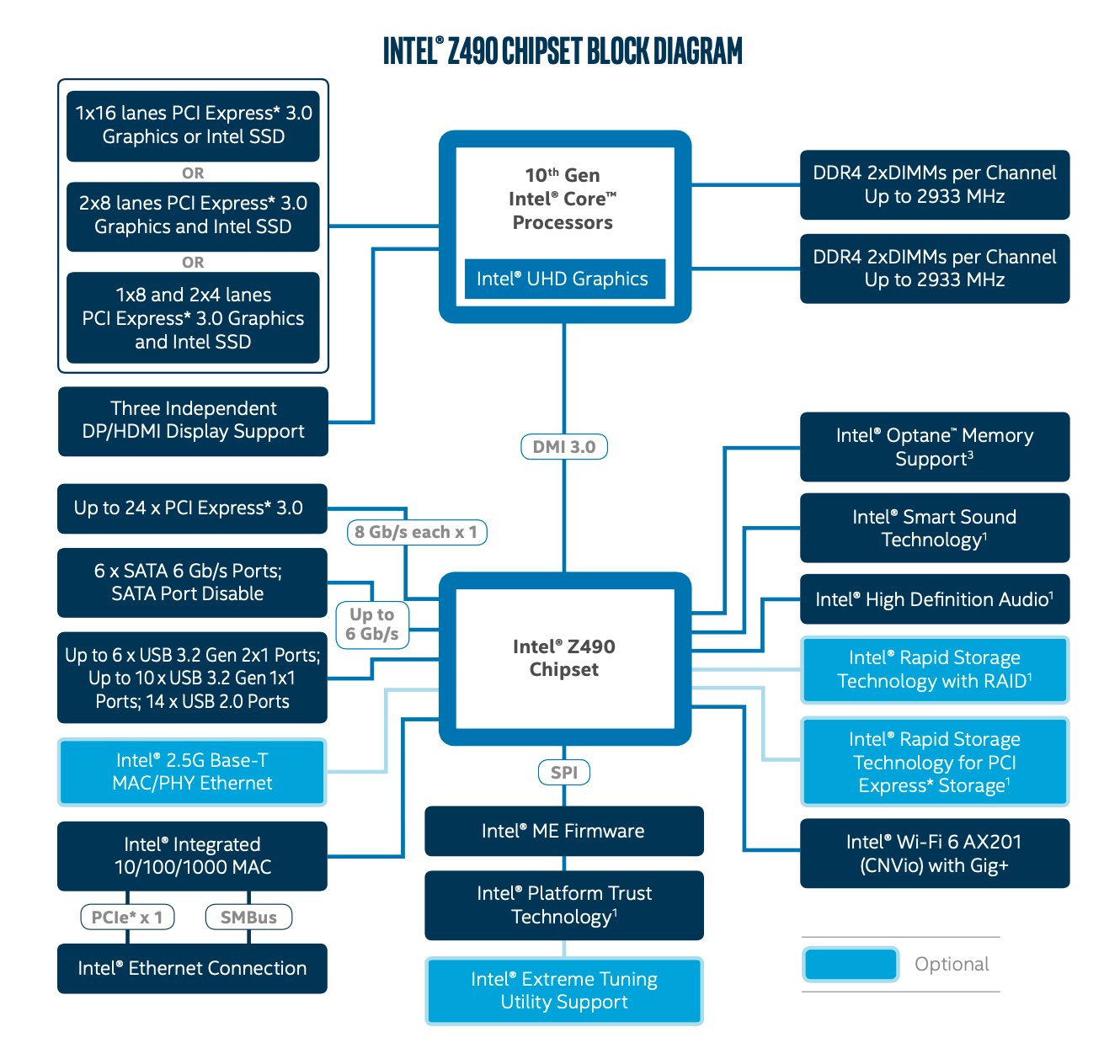
Intel's 10th gen lineup will require a new LGA1200 socket, so there's no backwards compatibility with older motherboards. You'll need to grab a new motherboard, and starting today you'll probably see a lot of news about Z490, B460 and H410 offerings.
You can expect us to begin testing many Intel Z490 boards in the next few weeks.
What do these boards actually offer? Aside from things makers control like VRMs, connectivity and so forth, Z490 isn't that much different to Z390. We'll see more 2.5 Gb Ethernet solutions as Intel are officially supporting it this generation with their Foxville chip, as well as more Wi-Fi 6 support.
Other than that you can expect beefy VRMs and power delivery systems with Z490 boards to accommodate 10 cores running at 4.8 GHz or more. MSI's Godlike, for example, has 16 90A power stages and even the budget Tomahawk has a 12 stage with an 8 and 4-pin EPS connector. A lot of budget Z390 boards used just 6 or 4 phase designs, but that looks to be changing with Z490 to accommodate the requirements of the 10-core.
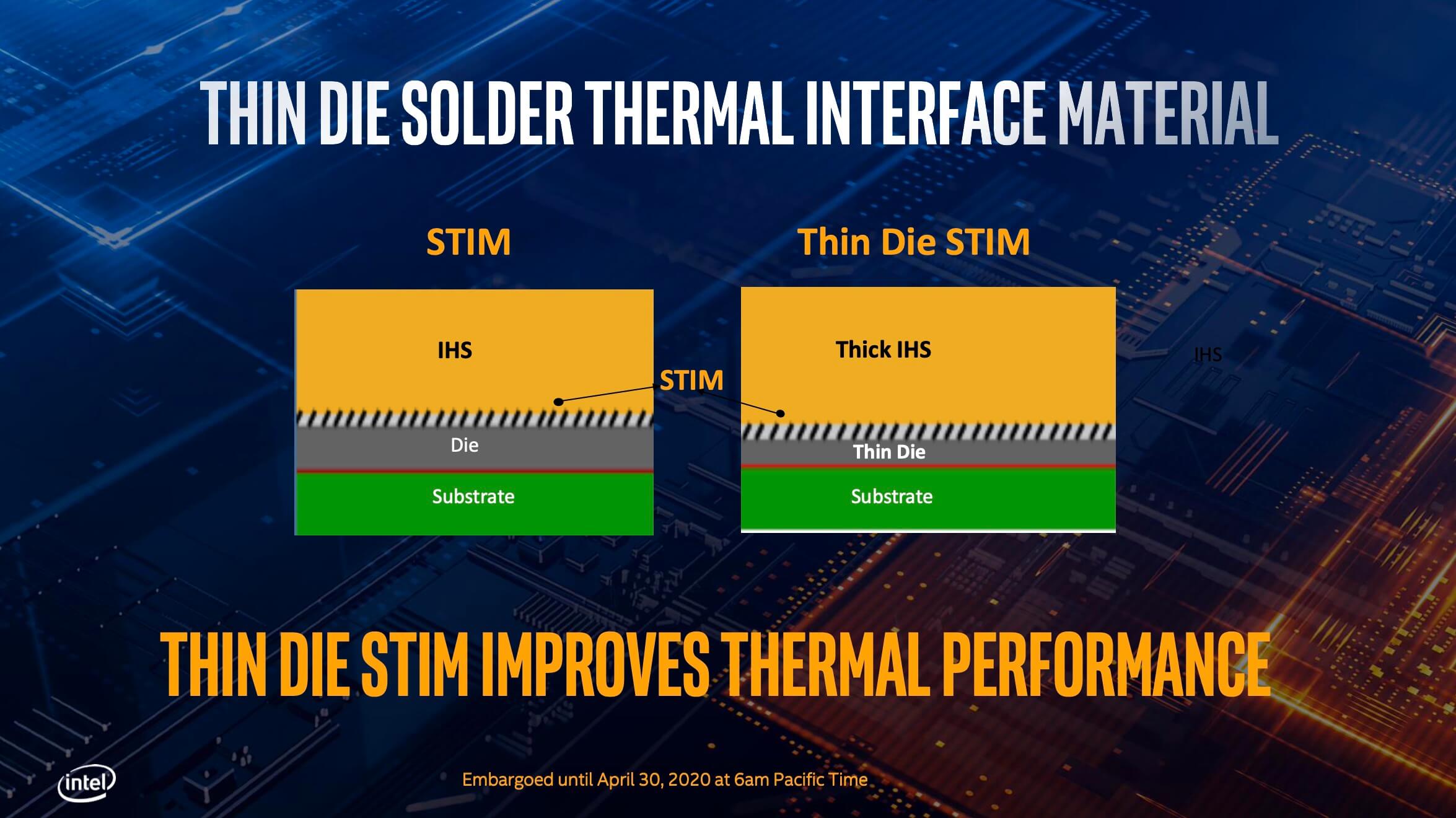
The more affordable Intel B460 motherboards don't offer anything too interesting. We saw some rumors claiming B460 would support overclocking but we checked with Intel, and confirmed, they do not.
Considering we were hitting heat output limits with the 9900K, Intel has made a few tweaks to help this situation with the Core i9-10900K. They've made the die itself thinner and the IHS thicker to improve thermal transfer, they're calling this "Thin Die STIM," so we are still getting a soldered chip but with the thinner silicon die it'll be easier for the heat to transfer out and into the IHS then the cooler.
A refreshed Intel Extreme Tuning Utility will allow better voltage-frequency curve controls as well as PEG and DMI overclocking and the unique ability to disable Hyperthreading on a per-core basis. Intel had some strange justifications for why you might want this for running applications that only use a certain number of threads, but this seems more like an enthusiast overclocking feature for maximizing performance.
Intel is making a few claims about where they expect new 10th gen parts to fall relative to previous generation CPUs and 3 year old PCs. You can see 10% faster performance in PUBG, for example, over the previous gen. Checking the configurations used, Intel is comparing the Core i9-10900K to the Core i9-9900K, although in this slide it appears Intel is power limiting both CPUs to a PL1 of 95W for the 9900K and 125W for the 10900K, the default TDPs for each processor. While you could argue about in-spec versus out-of-spec behavior, with 9th-gen parts, most motherboards ignored these limits by default. It'll be interesting to see how the CPUs stack up when unlimited and whether that's the default for 10th gen as well. We suspect the margins could be narrower when both are unleashed.
Intel claims the Core i9-10900K is the fastest gaming processor. In their own tests, they compared the 10900K to the 9900K and AMD Ryzen 9 3950X in 25 games with a GeForce RTX 2080 Ti, claiming that the 10900K performed better in the majority of titles. We saw nothing suspicious here, it's just unusual a company would bury these sorts of details in the footnotes. If the processor is actually the fastest in the majority of games, surely that's worth a couple more slides with more information.
Overall, this is shaping up to be a more exciting and interesting launch than we initially expected. The Core i7 and Core i5 range in particular, are better than we thought they might be, especially considering the list prices. Whether or not retailers actually sell the chips at these prices is another question, and often at launch prices can be inflated due to demand, but significant price cuts for 8 and 6-core parts are very welcome.
Intel's CPUs have been competitive in terms of performance all along, but they've been hard to recommend because of pricing, especially in the mid-range. With this new line-up, Intel has done exactly what they needed to do. They couldn't continue offering 8 cores at nearly $500 and expect to be competitive.

Of course, there's still plenty of things to discover that we'll work through in our upcoming reviews. Platform longevity in particular does not play to Intel's advantage. They have just launched a new socket and platform for this 10th gen lineup, so those upgrading from previous chips need to buy a new motherboard. Intel isn't making any commitments on how long LGA1200 and Z490 will last either, so we don't know whether this generation will support future CPU upgrades.
Another interesting discussion will be Intel 10th gen versus AMD's upcoming Zen 3. The new Intel CPUs look pretty competitive against Ryzen 3000, but those have been on the market for over 9 months now, and AMD loves to reduce prices in response to competition. That'll be a very interesting story to cover throughout the rest of 2020.




